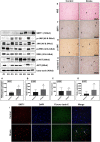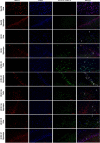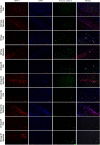Differential role of SIRT1/MAPK pathway during cerebral ischemia in rats and humans
- PMID: 33737560
- PMCID: PMC7973546
- DOI: 10.1038/s41598-021-85577-9
Differential role of SIRT1/MAPK pathway during cerebral ischemia in rats and humans
Abstract
Cerebral ischemia (CI) is a severe cause of neurological dysfunction and mortality. Sirtuin-1 (Silent information regulator family protein 1, SIRT1), an oxidized nicotinamide adenine dinucleotide (NAD+)-dependent protein deacetylase, plays an important role in protection against several neurodegenerative disorders. The present study aims to investigate the protective role of SIRT1 after CI in experimental young and aged rats and humans. Also, the study examines the possible regulatory mechanisms of neuronal death in CI settings. Immunoblotting and immunohistochemistry were used to evaluate changes in the expression of SIRT1, JNK/ERK/MAPK/AKT signaling, and pro-apoptotic caspase-3 in experimental rats and CI patients. The study findings demonstrated that, in aged experimental rats, SIRT1 activation positively influenced JNK and ERK phosphorylation and modulated neuronal survival in AKT-dependent manner. Further, the protection conferred by SIRT1 was effectively reversed by JNK inhibition and increased pro-apoptotic caspase-3 expression. In young experimental rats, SIRT1 activation decreased the phosphorylation of stress-induced JNK, ERK, caspase-3, and increased the phosphorylation of AKT after CI. Inhibition of SIRT1 reversed the protective effect of resveratrol. More importantly, in human patients, SIRT1 expression, phosphorylation of JNK/ERK/MAPK/AKT signaling and caspase-3 were up-regulated. In conclusion, SIRT1 could possibly be involved in the modulation of JNK/ERK/MAPK/AKT signaling pathway in experimental rats and humans after CI.
Conflict of interest statement
The authors declare no competing interests.
Figures







Similar articles
-
SIRT1 regulates MAPK pathways in vitiligo skin: insight into the molecular pathways of cell survival.J Cell Mol Med. 2014 Mar;18(3):514-29. doi: 10.1111/jcmm.12206. Epub 2014 Jan 10. J Cell Mol Med. 2014. PMID: 24410795 Free PMC article.
-
SIRT1 mediates salidroside-elicited protective effects against MPP+ -induced apoptosis and oxidative stress in SH-SY5Y cells: involvement in suppressing MAPK pathways.Cell Biol Int. 2018 Jan;42(1):84-94. doi: 10.1002/cbin.10864. Epub 2017 Oct 25. Cell Biol Int. 2018. PMID: 28851138
-
Resveratrol protects retinal ganglion cell axons through regulation of the SIRT1-JNK pathway.Exp Eye Res. 2020 Nov;200:108249. doi: 10.1016/j.exer.2020.108249. Epub 2020 Sep 18. Exp Eye Res. 2020. PMID: 32956685
-
Research Progress on the Role of Sirtuin 1 in Cerebral Ischemia.Cell Mol Neurobiol. 2023 Jul;43(5):1769-1783. doi: 10.1007/s10571-022-01288-3. Epub 2022 Sep 24. Cell Mol Neurobiol. 2023. PMID: 36153473 Free PMC article. Review.
-
The Critical Role of Sirt1 in Subarachnoid Hemorrhages: Mechanism and Therapeutic Considerations.Brain Sci. 2023 Apr 18;13(4):674. doi: 10.3390/brainsci13040674. Brain Sci. 2023. PMID: 37190639 Free PMC article. Review.
Cited by
-
The impact of aging and oxidative stress in metabolic and nervous system disorders: programmed cell death and molecular signal transduction crosstalk.Front Immunol. 2023 Nov 8;14:1273570. doi: 10.3389/fimmu.2023.1273570. eCollection 2023. Front Immunol. 2023. PMID: 38022638 Free PMC article. Review.
-
Stem Cell Therapy Modulates Molecular Cues of Vasogenic Edema Following Ischemic Stroke: Role of Sirtuin-1 in Regulating Aquaporin-4 Expression.Stem Cell Rev Rep. 2025 Apr;21(3):797-815. doi: 10.1007/s12015-025-10846-3. Epub 2025 Jan 31. Stem Cell Rev Rep. 2025. PMID: 39888572
-
Sirtuins Modulation: A Promising Strategy for HIV-Associated Neurocognitive Impairments.Int J Mol Sci. 2022 Jan 7;23(2):643. doi: 10.3390/ijms23020643. Int J Mol Sci. 2022. PMID: 35054829 Free PMC article. Review.
-
SIRT1, a novel transcriptional downstream target of CD44, linking its deacetylase activity to tumor cell invasion/metastasis.Front Oncol. 2022 Nov 23;12:1038121. doi: 10.3389/fonc.2022.1038121. eCollection 2022. Front Oncol. 2022. PMID: 36505828 Free PMC article. Review.
-
Innovative therapeutic strategies for cardiovascular disease.EXCLI J. 2023 Jul 26;22:690-715. doi: 10.17179/excli2023-6306. eCollection 2023. EXCLI J. 2023. PMID: 37593239 Free PMC article. Review.
References
Publication types
MeSH terms
Substances
LinkOut - more resources
Full Text Sources
Other Literature Sources
Research Materials
Miscellaneous

